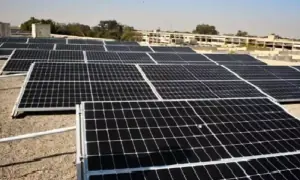Social media ‘experts’ clueless about cuts in bunds: Sindh CM
KARACHI: The Sindh government’s decision to give relief cuts to any embankment was made in consultation with Irrigation experts, top engineers of the Army Corps, and even retired Irrigation chief engineers, the chief minister has said.
“The so-called experts on social and mainstream media are making baseless statements about the relief cuts,” he said at a press conference on Wednesday. The government tried to flood katcha areas to protect the pacca areas. “The decisions might have some mistakes but were taken with proper consultation with experts and sincerity.”
Murad Ali Shah said that the province received unprecedented rains of 1,100 mm and an additional 30 million acre-feet (MAF) from Balochistan’s Hill torrents on the right bank of the River Indus, leading to a humanitarian crisis which the government is fighting.
He spoke on Wednesday, flanked by Information Minister Sharjeel Inam Memon, Excise Minister Mukesh Chawla, and Special Assistant Syed Qasim Naveed at a press conference at CM House.
To contain hill torrents, the flood protection (FP) bund was erected six feet high after the floods of 2010 but even then, this year the water was so strong that it caused five breaches and flooded towns and villages in its way on the right bank.
On the Left of the River Indus, major cities like Shaheed Benazirabad, Sanghar, Umerkot, Mirpurkhas and Badin are located. Their water would be discharged into Shakoor Lake or Dhand and the cities and towns located near River Indus would have to pump their water into them. But, this will take time, he added because there is just so much water.
The river levels at Guddu and Sukkur barrages is normal, as the high flood passed and water levels are declining.
The levels of inundation on the right bank of Sukkur Barrage have gone down. The overall level is depleting in the upper areas of Taluka Qubo Saeed Khan, Shahdadkot, Kambar, Warah, and Nasirabad.
Rice Crops:
The chief minister said that paddy was sown over an area of 1,487,870 acres, of which 1,063,273 or 71.46 percent have been damaged. “I am trying to protect the crops still standing over an area of 52,100.37 acres by providing them water,” he added. He has directed the Irrigation department to open the Rice Canal, NW Canal, and other branches to provide water to the rice crop.
Relief goods
The chief minister said that on September 13, the PDMA, NDMA, Pak Army, Air Force, and other organizations provided 185,561 tarpaulin sheets. Similarly, 1541,937 mosquito nets have been providedby September 13.
So far 425,321 ration bags have been provided, including 17,750 on September 13 and 406,446 litres of drinking water have been distributed.
Health facilities
The chief minister told the media that 576 medical camps, including 170 fixed and 406 mobile camps have been set up by the health department, the People’s Primary Healthcare Initiative (PPHI), and other partners where 735 doctors, 1443 paramedics, and 265 nurses were on duty.
On September 13 alone, 19456 gastro-related, 22,156 skin-related, 11,329 Malaria (suspected), 64 dengue (suspected), and 49,015 people with other diseases were treated. Three patients died. The number of patients who have died so far comes to 172.
Disease prevalence in the province in September included 19,456 gastro, 22,156 skin, 11,329 Malaria, 64 dengue, and 49,015 other diseases.
To another question, the CM said that $15 million were needed to construct houses that collapsed in the floods. The agriculture sector suffered a loss of Rs380 billion when standing crops were submerged.
For the latest news, follow us on Twitter @Aaj_Urdu. We are also on Facebook, Instagram and YouTube.
















Comments are closed on this story.